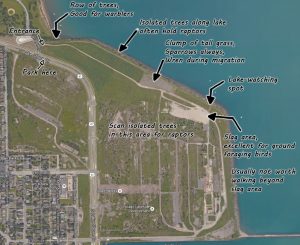Sibley Grove is a mesic savanna and wetland complex that is probably the best remaining example of a mesic savanna, pond, marsh, and prairie complex in east-central Illinois. The grove of oak trees found here, including some nearly 400 years old, dominates a ground layer that is being restored, with ongoing removal of honeysuckle, buckthorn, and other invasive and non-native plants. The 50 acre site is owned and managed by the Nature Conservancy.
From the junction in the town of Sibley of Illinois Route 47 and County Road 1300N proceed south on Route 47 to Ohio Street, turn east (left) onto Ohio Street, proceed 0.75 mile, turn south (right) on County Road 480E, proceed 0.75 mile, turn east (left) on County Road 1250N. You are now on the north side of the preserve. Proceed less than a quarter-mile to the small grass parking lot on the south side of County Road 1250N east of the marsh.
The main attraction of Sibley Grove from a birding perspective is not its great species diversity, although it appears to be birded very little, so it’s hard to say how many species actually occur here. Rather, it is the combination of excellent natural habitat in the otherwise seemingly endless agricultural landscape of Ford County, which is flat, dominated by corn and soybean fields, has few water bodies, and where most of the watercourses are little more than drainage ditches. Sibley Grove deserves more attention from birders in order to discover what species do occur here, and if you are a county lister it’s almost the only decent natural habitat in Ford County.
Because of the combination of habitat types in a small site species diversity could be higher than what has already been recorded. Puddle ducks, pied-billed grebe, great blue heron, great egret, and American coots have been observed on the pond. Shorebirds include American golden-plover, killdeer, lesser yellowlegs, and least, solitary, and spotted sandpipers. Upland areas host the expected woodland species including black-capped chickadee, white-breasted nuthatch, house wren, kinglets, thrushes, wood warblers, sparrows, and blackbirds.
